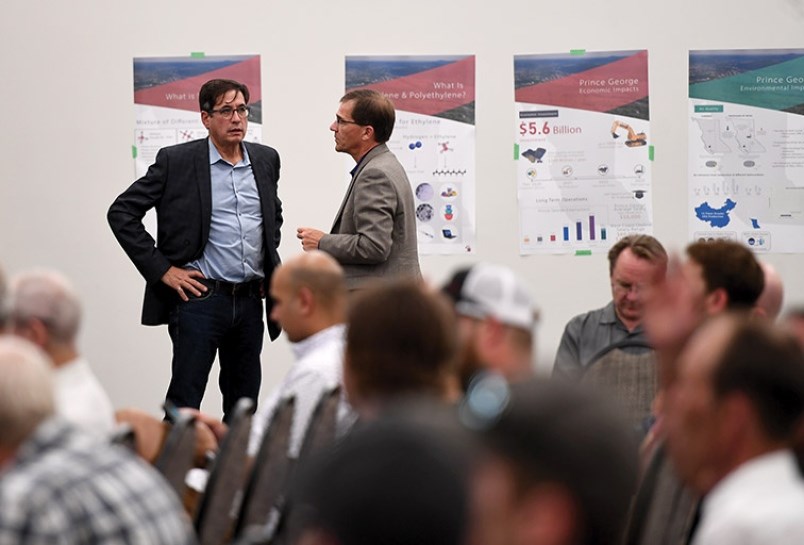A preliminary project description is now on the B.C. Environmental Assessment Office website for a component of an ambitious petrochemical complex in Prince George.
The 143-page document was posted on Thursday, and marks the formal beginning of the EAO's review of West Coast Olefin Ltd.'s proposal to build an ethylene plant on a 120-hectare (300-acre) property in the BCR Industrial Site.
It's one of three major components of a petrochemical complex proposed for Prince George, along with an ethylene derivatives plant and a natural gas recovery system.
According to the document, the ethylene plant would use feedstock from Enbridge's West Coast natural gas pipeline primarily to produce about one million tonnes per year of polymer-grade ethylene.
In turn, most of that would go to the adjacent ethylene derivatives plant at the BCR to produce polyethylene - essentially plastic in pellet form - and possibly mono-ethylene glycol - used as antifreeze and heat transfer fluid - for export to Asia.
The polyethylene plant, in turn, would be "developed by others." Like WCOL's ethylene plant, the derivatives plant would also go through the province's environmental assessment process.
Meanwhile, a subsidiary of WCOL would operate a natural gas recovery system, consisting of an extraction plant adjacent to the pipeline and connected to a separation plant at the BCR, 10 kilometres away.
The separation plant would produce ethane, propane, butane and condensate. While the ethane would go to WCOL's ethane plant, the propane and butane would be loaded into rail cars and sent to Prince Rupert or Kitimat for export to Asia.
The condensate, in turn, would be sent by rail to Alberta for sale into the condensate pool or could potentially be sold as feedstock to the Husky refinery in Prince George.
The natural gas recovery system would be subject to a review by the Oil and Gas Commission.
Proponents have said the projects are to add up to $5.6 billion worth of construction and employ about 1,000 people once completed.
According to the submission to the EAO, the ethylene plant would account for as much as $2.8 billion of that total, with the construction expected to span from the spring 2021 to summer 2023 and generate 2,000 to 3,000 jobs at its peak.
Once completed, it would employ 140 to 180 employees directly and 25 to 50 contract employees during commercial operation, and have an initial lifespan of about 25 years.
"In addition to this, the local community will experience multiple indirect benefits, such as support of local services and inclusion of local institutions for training purposes," WCOL added in the submission.
On the environmental impact, WCOL says it is "committed to best-in-class environmental performance." In answer to concerns about the impact on the city's air quality, it says primary fuel will be ethylene plant offgas, that consists of mostly hydrogen and methane, and lean natural gas.
"These are very clean-burning fuels that emit no odour and negligible particulate matter," WCOL says. "The Project will be designed with vapour recovery systems and fugitive emission monitoring systems to minimize fugitive emissions and odours."
And while critics have maintained it should be located in an area of the Hart designated for heavy industry, WCOL says the BCR site was chosen "to minimize the use of undisturbed land, thereby minimizing potential environmental impacts from the facility location."
And it says the plant will be designed to "minimize impacts on the important fisheries of the Fraser and Nechako Rivers" with most of the water it will need being used for non-contact cooling water "to minimize the volumes required and minimize the risk of contamination by the petrochemical process."
"The plant will be designed to treat and recycle process water streams wherever practical. Any water that is released into the river will be cooled in the cooling water circuit, treated and tested to ensure that it exceeds all regulatory standards."
Next steps include a review by a technical working group and an opportunity for public comment, which has not yet started. The EAO has 180 days to carry out the review although the period can be extended if there is a need for more information or the proponent asks for one.
From there, WCOL's application would be forwarded to the Minister of Environment and Climate Change Strategy and the Minister of Energy, Mines and Petroleum Resources, who have 45 days to decide on whether an environmental assessment certificate should be issued and whether the certificate should come with conditions. They can also call for further study or assesssment.
The posting can be found through projects.eao.gov.bc.ca.



